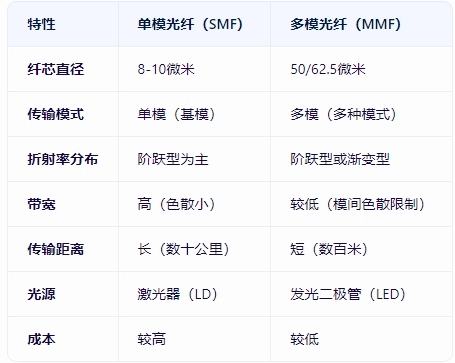
Blog
blog Location: Home > Blog > Technical Article
Location: Home > Blog > Technical Article
 Update Time:2025-08-16
Update Time:2025-08-16 Traffic:
Traffic: Single-mode fiber (SMF) and multi-mode fiber. The main differences in the structure of MMF are reflected in the following aspects:
1. Core diameter
Single-mode fiber: The core diameter is extremely small, usually 8-10 microns. This design allows only one mode of light (fundamental mode) to propagate through the core.
Multimode fiber: The core diameter is larger, typically 50 microns, or 62.5 microns. The larger core allows multiple modes of light waves to travel simultaneously.
2. Refractive index distribution
Single-mode fiber: usually uses a step index distribution (constant refractive index of the core, sudden decrease in the refractive index of the cladding). This structure helps to reduce mode dispersion and is suitable for long-distance transmission.
Multimode fiber:
Step multimode fiber: The refractive index distribution is similar to that of single-mode fiber, but the core is larger.
Gradual change multimode fiber: The refractive index of the core gradually decreases from the center to the outside (parabolic distribution), which can reduce the inter-mode dispersion and improve the bandwidth.
3. Cladding and coating
Cladding: Both cladding layers are 125 microns in diameter and are made of fluorine-doped silica with a lower refractive index than the core to ensure total reflection.
Coating layer: The outer layer is made of polymeric material (e.g. acrylate), which is used to protect the fiber and enhance the mechanical strength. There is usually no essential difference in the structure of single-mode and multi-mode coating layers.
4. Materials and doping
Core material: All are mainly silicon dioxide (SiO2), but single-mode fiber cores may be doped with germanium (Ge) to increase the refractive index, while multimode fibers may be less doped or use other formulations.
Manufacturing accuracy: Single-mode fiber requires higher accuracy in core size and refractive index distribution, making it more difficult to manufacture.
5. Transmission mode and performance
Single-mode fiber: supports only a single mode, with small dispersion (mainly limited material dispersion), suitable for long-distance (tens of kilometers) and high-bandwidth transmission (e.g. long-distance communication, submarine cable).
Multimode fiber: supports a variety of modes, with large inter-mode dispersion, short transmission distance (usually within a few hundred meters), but low cost, often used in short-distance networks (e.g. data centers, local area networks).
summary comparison table

application scenario
Single-mode fiber: long-distance communication, Internet backbone, submarine cable, CATV.
Multimode fiber: local area network (LAN), data center, short-range fiber to the home (FTTH).
Through differences in structural design, single-mode and multimode fibers optimize the requirements for long-distance high-bandwidth transmission and short-distance low-cost communication, respectively.
